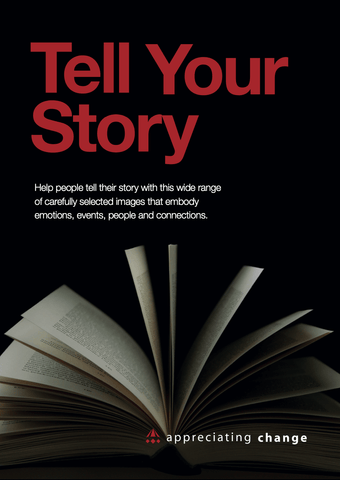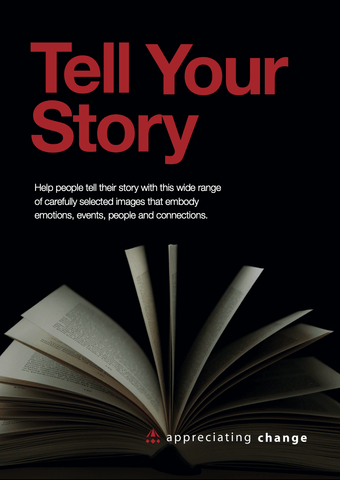Creative Workshop Exercises: Easy and Engaging Activities #2 Take a Sad Story and Make It Better. Use Tell Your Story Cards to Create Optimism, Hope and Possibility
Impact: Increased hope and investment in the future
Materials needed: Tell Your Story Cards by Appreciating Change
Remember, should you decide to buy a pack, you can get 10% off your first shop order with a newsletter subscription

Professional Use: Coaching, Therapy, Counselling
Who is this Tell Your Story exercise for?
This exercise is designed to help anyone who has become stuck in a downward cycle of despair or hopelessness and feels stuck. The aim of the exercise is to change the story being told about the situation to one that offers scope for positive and pro-active ways forward. This is done by exploring unseen opportunities, possibilities and contexts present in the story. The cards are used to externalise the story into representative elements that can be physically and easily manipulated to suggest alternative or additional interpretations, perspectives or accounts.
How does this Tell Your Story exercise help with creating hope and investment in the future?
When people are in a difficult place emotionally, it can become very hard for them to feel hopeful about the possibilities for change. By externalising the story it becomes possible to co-create further ideas about how the situation can be understood. This can be done, for example, by highlighting overlooked aspects of the story or by introducing new elements. In this way a more optimistic account of possibilities for action which generate hope for the future can be created. Once hope has been re-ignited, active investment in achieving a better future becomes possible.
How to conduct the Take a Sad Story and Make It Better exercise
Preparation
(Note all cards in pack are double sided)
- Remove title card

- First ask the person to share, in words, what is happening and why they feel stuck. Listen for any hope you can hear in the story which they don’t. Listen for potential positives that are being overlooked. Listen for resources – people, their personal strengths or brief references to hopes and aspirations and make a written or mental note of them.
- Next, spread all the cards out. Point out that the cards contain both images and ‘connector’ cards, and that they are double sided. Be sure to show emotion emoji cards and connector cards as well as images. Explain that the images can be used both literally, for example as a picture of a house, or metaphorically. In this instance the house image could be used to represent security or safety, for example.


- Ask the person to look carefully at the cards, both sides, and then to select images they want to assemble to lay out their story, thoughts and feelings. While they are doing this start noticing which cards you might to select to add in your observations of sources of optimism, hope, resourcefulness, their strengths and so on.
- Encourage the person to talk through their story as they arrange their selected cards. Ask what they notice about their story, and if anything feels different now the story is laid out in front of you both.
- Every person’s story will be their own of course, here is a simplified example. In brief the story laid out below is: I used to be really active, and felt as if I was flying high. Then I got married and had kids, they’re great but really tiring. And now life just feels like an uphill slog. I feel I’ve lost my way.








- Ask their permission to make observations about their story and to add to it. In this instance there are a number of ways one could take the conversation forward.
- For example, one could ask them, what is most precious to you about your life at present, using the card below to represent ‘preciousness’. This will help them sort the wheat from the chaff in all the things going on in their life. This kind of question helps people prioritise what is really important to them. It might be helpful to also explore what is outside the nest?

- Or, you could pick up on some of the positives you heard in the story, for example they might have referred in passing to their partner as being the love of their life, or maybe a friend had been a great support, or perhaps you were struck by the love they clearly had for their family. This leads in the direction of helping them recognize other ‘truths’ in their story. The cards below illustrate these ideas. This process highlights some of the currently un-noticed positives, which can then be further explored. What conversation could she and her partner usefully have? Could the friend babysit so they could have this conversation uninterrupted? And so on.



- Or, you could pick up on an element of their past life that they could perhaps re-introduce. This is about identifying resources to aid resilience. See cards below. While resurrecting surfing might be difficult, skateboarding as a family, or just dancing at home might be possible. Could she find a few minutes in a day to just dance? Could they go skateboarding at the weekend? What would building some enjoyable, easy to make happen, exercise into her life do for her? What might need to be removed from her story for her to be able to believe she could add this into her life without adding extra stress?


- The conversation can continue in this way, with questions being asked and cards being manipulated until energised ideas for different ways forward begin to emerge. In our example that might include a plan to arrange time with the partner to talk about how she can organise to return to work part-time, and, an arrangement to go out dancing once a week with her friend. These would be two small steps that call on her resources and start to move life in a different direction.



- To conclude. Ask her, looking at all the cards now in play, to tell her story again, including particularly what she wants to do, following this conversation, to change things.
This card pack is available exclusively at the Positive Psychology Shop. A discount of 10% is available to newsletter subscribers.
If you have any queries about the exercises as described, please contact Sarahlewis@acukltd.com. We will publish any queries and answers in the next newsletter to the benefit of all.
Please feel free to share the link to this page with any colleagues you feel may be interested. Or, direct them to the homepage where they can subscribe to the newsletter for free.

